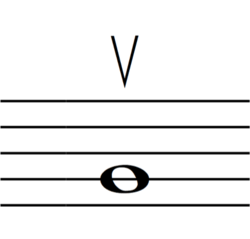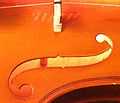Up bow


An up-bow is a type of stroke used when bowing a musical instrument, most often a string instrument. The player draws the bow upward or to the left across the instrument, moving the point of contact from the bow's tip toward the frog (the end of the bow held by the player).[1]
Instruments
How the up-bow is achieved varies depending on the shape and orientation of the instrument.
| Instrument | How the player achieves the up-bow |
|---|---|
| Violin | The player pushes the bow up, toward the left shoulder |
| Viola | The player pushes the bow up, toward the left shoulder |
| Cello | The player pushes the bow to the left, toward the left elbow |
| Double bass | The player pushes the bow to the left, toward the left elbow |
Uses
String players can exert stronger pressure on the string when bowing near the frog than when bowing near the tip, due to the bowing hand's proximity to the bow's contact point with the string. Up-bows, which begin near the tip, are therefore often used to play the upbeats (weaker beats) within a musical phrase. Notes that begin quietly and crescendo are also ideally up-bowed — from tip to frog — allowing pressure on the string to increase naturally.
See also
References
| |||||||||||||||||||
